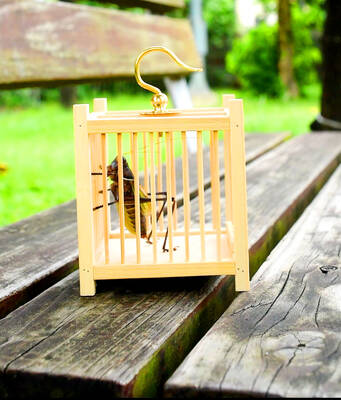Hedvig Frederiksen was 14 years old when her Danish headmistress sent the girls from her class to a hospital in Paamiut in Southwestern Greenland.
Sitting anxiously in the waiting room, Frederiksen had no idea why she was there. One by one her classmates’ names were called, and one by one they returned from the examination room crying and clutching their bellies.
She remembers little about her own turn in the room; just the excruciating pain that followed, longing for her parents, and the silence in the girls’ dormitory that night in 1974. Frederiksen now knows she had been fitted with an intrauterine device (IUD), commonly known as a coil, a procedure carried out on thousands of Inuit girls by the Danish government to curb population growth in its former colony.

Photo: AP 照片:美聯社
Now 63, Frederiksen only recently began to talk about what happened to her.
“It was very traumatic. I was just a kid; I wasn’t sexually active. I didn’t know what the word coil meant, or what it was,” Frederiksen said. Even today, many victims still feel shame and guilt about the procedures, she said.
Frederiksen is one of 143 women who are suing the Danish state, claiming that for decades it violated the Inuit women’s human rights through its so-called family planning efforts. In a lawsuit filed Monday last week, they are seeking compensation of 300,000 kroner (US$43,700) each — a total of US$6.3 million — but for the Danish state there could be much more at stake.

Photo: BruceBlaus /Wikimedia Commons 照片:BruceBlaus∕維基共享資源
The scandal is the latest in a string of revelations of past misconduct by Danes in Greenland that are gaining prominence at a time when the autonomous territory is inching towards full independence and increasingly aware of the attention it’s attracting as a geopolitical asset.
While Greenland’s status as a Danish colony officially ended in 1953, Copenhagen still controlled the island’s health-care system until 1991. To this day, Denmark oversees some affairs, including foreign policy and security, in the Arctic territory, which has a population of just 57,000.
In the 146-page lawsuit, Inuit women recount how as teenagers, but some as young as 12, they were fitted with a coil by Danish doctors. Girls were typically sent to hospital by their school, rarely told why and never gave consent. The experiences, and the high-risk IUD used at the time, left girls with traumatic memories as well as physical scars for life. Many became permanently infertile.
An investigation by Danish broadcaster DR found that in the late 1960s, about 4,500 of the 9,000 fertile women in Greenland were fitted with IUDs by Danish doctors. Birth rates more than halved.
Like many Greenlandic children from rural areas, Holga Platou was sent at 13 years old to complete school in the nearest town. Shortly after arriving in Maniitsoq in Western Greenland she was sent to the doctor during school hours. Now 63, Platou, who comes from a family of 10 siblings, tried for a baby for many years with her lifelong partner, but was never able to get pregnant after dealing with complications from the coil.
Platou never agreed to have a coil, but her traditional Greenlandic upbringing had taught her that authorities weren’t to be questioned.
For decades, Frederiksen and Platou kept quiet about what had happened. Girls across Greenland were doing the same. Only in 2017, when a woman called Naja Lyberth shared her story on Facebook, did Inuit women start talking. It still took five years for the scandal to gain global attention, following an investigation by the Danish broadcaster.
Denmark’s Prime Minister Mette Frederiksen has recognized that “serious crimes and missteps” were committed by Danes in Greenland, but said she will await an investigation commissioned by her government before drawing conclusions. Survivors fear it will drag out for years and that many of them, who are now in their 70s and 80s, won’t live to see the outcome.
(Bloomberg)
海德維格‧弗雷德里克森14歲時,學校的丹麥籍女校長將她班上的女孩送到格陵蘭島西南部帕米特的一家醫院。
弗雷德里克森焦慮地坐在候診室,不知道為什麼要來這裡。同學一個個被叫到名字,然後一一摀著肚子哭著從診察室出來。
她對自己在診察室裡的情況,幾乎不復記憶。所記得的只有隨之而來的極度疼痛、對父母的思念,以及1974年那個夜裡女生宿舍裡的寂靜。弗雷德里克森現在知道,她被裝了子宮內節育器,俗稱「線圈」,這是丹麥政府對這前殖民地數千名因紐特族原住民女孩所進行的手術,為的是抑制其人口成長。
現年63歲的弗雷德里克森最近才開口談及發生在她身上的事。
「這充滿了創傷。我還只是個孩子;我並沒有性生活。我不知道線圈這個詞是什麼意思,也不知道那是什麼」,弗雷德里克森說。即便時至今日,許多受害者仍對這些手術感到羞恥與罪惡,她說道。
弗雷德里克森是對丹麥政府提出告訴的143名婦女之一,她們說數十年來丹麥政府以所謂的計劃生育措施,侵犯了因紐特婦女的人權。在上週一提起的訴訟中,她們要求政府賠償每人30萬克朗(合43,700美元)——總計630萬美元——但對丹麥政府來說,可能還有更多的利害得失。
這起醜聞是丹麥人過去在格陵蘭的一連串不當行為被揭露的最新一起。格陵蘭這自治的島嶼,正逐步邁向完全獨立,並對其地緣政治之重要性所吸引的關注越來越有自覺,在此之際,這些醜聞也日益受到關注。
雖然格陵蘭的丹麥殖民地身分於1953年正式告終,但哥本哈根仍控制該島的醫療保健系統,直到1991年。時至今日,丹麥仍管理格陵蘭的一些事務,包括外交政策與安全。位於北極地區的格陵蘭,人口只有五萬七千人。
在長達146頁的訴狀中,因紐特婦女陳述她們在青少年時期(有些人年僅12歲)被丹麥醫師安裝子宮內避孕器的情形。一般的情況是,女孩被學校送到醫院,很少被告知原因,也從未表示同意。這些經歷以及當時使用的高風險子宮內避孕器,給女孩留下了創傷的記憶,以及一輩子的身體傷害。許多人終身不孕。
丹麥廣播公司的一項調查發現,在1960年代晚期,格陵蘭島9,000名育齡婦女中,約有4,500名被丹麥醫師裝了子宮內避孕器。這使得出生率減少了一半以上。
和許多來自農村地區的格陵蘭兒童一樣,霍爾加‧普拉圖13歲時就被送到最近的城鎮完成學業。她抵達格陵蘭西部的馬尼特索克後不久,就在上學時間被送到醫生那裡。現年63歲的普拉圖來自一個有10個兄弟姐妹的家庭,多年來她和其終身伴侶一直想要生孩子,但在處理子宮內避孕器所引起的併發症後始終未能懷孕。
普拉圖從未同意裝子宮內避孕器,但她成長的格陵蘭傳統教育告訴她,權威不容質疑。
數十年來,弗雷德里克森和普拉圖對所發生的事三緘其口,格陵蘭各地的女孩亦然。直到2017年,一位名叫娜亞‧李柏的女士在臉書上分享了她的故事,因紐特婦女才打破沉默。在丹麥廣播公司進行調查後,這起醜聞花了五年的時間才得到全球關注。
丹麥首相梅特‧佛瑞德里克森承認,丹麥人在格陵蘭犯下了「嚴重罪行與過失」,但表示她將等待政府所委託的調查進行後,再做出結論。倖存者擔心這會持續數年,而其中許多人(現已七十多歲及八十多歲)將無法在有生之年看到結果。
(台北時報林俐凱編譯)

A: Google has unveiled its 2025 Year in Search chart. No. 10 to No. 6 are: Typhoon Podul, Chinese drama “Love’s Ambition,” tariffs, US President Donald Trump and singer Khalil Fong’s death. B: Wow, actress Rosy Zhao’s new drama is so popular. So what are the top five? A: No. 5 to No. 1 are: Gemini, hanzii.net, NT$10,000 cash handout, entertainer Big S’ death and earthquakes. B: Hasn’t Trump topped this year’s most-searched people chart? A: Yup, and he’s closely followed by cheerleader GuoGuo Chiang at No. 2, whose husband Zack Fanchiang is also at No. 8. Apparently, people are curious about her extramarital

A: Compared to Taiwanese, what did Americans search for most in 2025? B: No. 10 to No. 6 are: Tariffs, FIFA Club World Cup, government shutdown, DeepSeek and incoming New York mayor Zohran Mamdani. A: Mamdani is set to take office on Jan. 1. And what are the top five? B: No. 5 to No. 1 are: the One Big Beautiful Bill Act, iPhone 17, Labubu doll, animated blockbuster KPop Demon Hunters and political activist Charlie Kirk’s assasination. A: The only term to appear on both the Taiwanese and US charts is tariffs. A: 跟台灣人相比,美國人都在搜尋什麼? B: 第10到6名是:關稅、FIFA俱樂部世界盃、政府關閉、DeepSeek語言模型、候任紐約市長佐蘭曼達尼。 A: 曼達尼元旦即將就任,前5名是什麼? B: 第5到1名是:《大而美法案》、iPhone 17、拉布布玩偶、動畫片《KPop獵魔女團》、政治活動家查理柯克遇刺。 A: 看來台、美熱搜榜唯一的共同議題就是--關稅! (By Eddy Chang, Taipei

The world is teeming with danger and unpredictability. To safeguard themselves from harm and invite good fortune, people across cultures carry or display symbolic charms and trinkets. It is common to see beckoning cat figurines in stores in Japan, while people in China have historically kept crickets in cages for good luck. Even flora can serve as emblems of luck, with the four-leaf clover standing out as perhaps the most iconic. A clover is a small plant that typically grows 10 to 30 cms in height. While there are many species of clover, the variety that people consider to

The content recommendation algorithm that powers the online short video platform TikTok has once again come under the spotlight after the app’s Chinese owner ByteDance signed binding agreements to form a joint venture that will hand control of operations of TikTok’s US app to American and global investors, including cloud computing company Oracle. Here is what we know so far about its fate, following the establishment of the joint venture. IS BYTEDANCE CEDING CONTROL? While the creation of this new entity marks a big step toward avoiding a US ban, as well as easing trade and tech-related tensions between Washington and Beijing, there